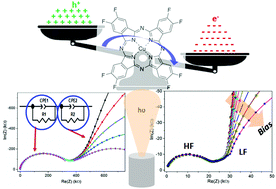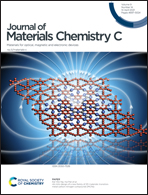Photon assisted-inversion of majority charge carriers in molecular semiconductor-based organic heterojunctions†
Abstract
Ambipolar molecular materials hold great promise as a building block of next generation highly efficient, less complex and low cost electronic devices. In this endeavor, the present work reports the fabrication of organic heterojunction devices based on halogenated copper phthalocyanine (CuPc) and lutetium bisphthalocyanine (LuPc2) bilayers, investigates their structural and electrical properties and probes the ambipolar behavior by ammonia sensing. Microstructural analysis of the heterostructure thin films revealed compact and semicrystalline organization, depending on the number of halogen substituents in CuPc. The heterojunction devices reveal non-linear I(V) characteristics associated with an interfacial energy barrier which is tuned by the number and type of halogen substituents. The behavior of the devices towards NH3 exposure revealed n-type, p-type and ambipolar transport depending on 16, 0 and 8 fluorine substituents, respectively, present in the CuPc component of the heterostructure, demonstrating a correlation between the electronic effects of substituents and the thin film electrical properties. The trigger of the ambipolar transport regime in the heterojunction device is the visible light, such that the device conduction channel is dominated by holes in the dark and electrons under illumination. In depth charge transport studies by impedance spectroscopy explain the device electrical behavior and highlight the important role played by the interface in the heterostructures. Different charge transport parameters are extracted by fitting the experimental Nyquist curves, analysis of those confirms the presence of bulk and interfacial transport and provides an interpretation of the observed ambipolarity.



 Please wait while we load your content...
Please wait while we load your content...